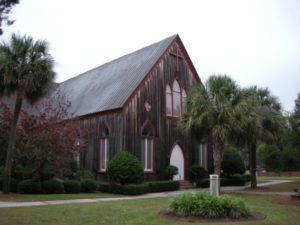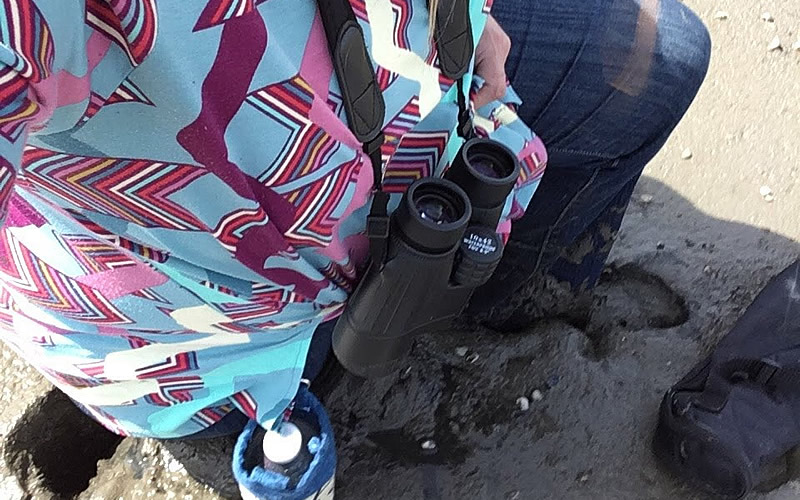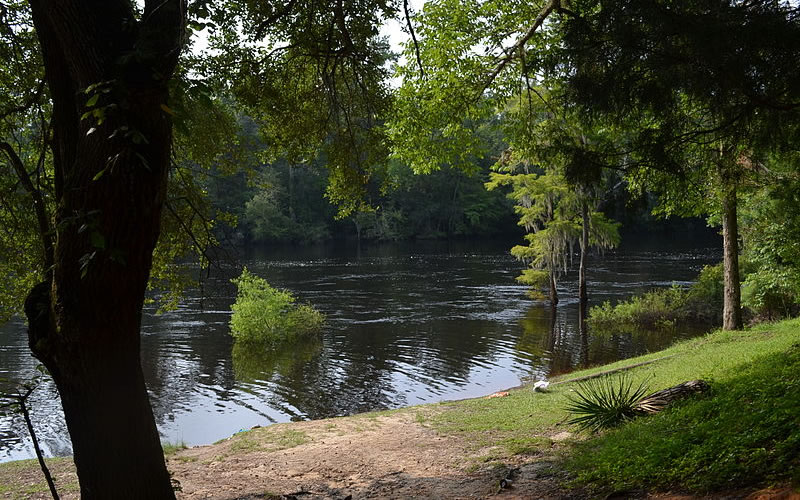FOCUS: Architect unveils Emanuel AME Church memorial design
COMMENTARY, Brack: Teach your children to swim
IN THE SPOTLIGHT: Magnolia Plantation and Gardens
GOOD NEWS: Big ladybug release set for July 21 at Magnolia
WHAT WE LOVE: Pluff mud in the morning
FEEDBACK: Send us your thoughts
MYSTERY PHOTO: Imagine the bugs in this place
S.C. ENCYCLOPEDIA: Edisto River
CALENDAR, July 16+: Shark Week is ahead
FOCUSFOCUS: Architect unveils Emanuel AME Church memorial design

Rendering from Calhoun Street of fellowship benches, fountain and congregation. Credit: Image courtesy Dbox for The Mother Emanuel Nine Memorial / Handel Architects
Staff reports | Architect Michael Arad revealed design plans July 15 for a permanent memorial honoring the victims of the 2015 shooting that left dead nine members of Emanuel AME Church on Calhoun Street.
Arad, the architect behind the National September 11 Memorial in New York, conveyed his inspiration for the Emanuel Nine Memorial at the church following a ceremony celebrating its 200th anniversary.
“The inspiration for this memorial draws on Mother Emanuel A.M.E. Church as a historic place and as a congregation,” Arad said in a statement. “Throughout its 200-year history, it has endured slavery, discrimination and racism. When worship and assembly were banned, the church resisted and provided a place of fellowship and sanctuary.
“The Emanuel Nine tragedy marks another dark moment for the church, though faith helped to heal and bring light into the darkness.”
According to a press release, the memorial honors the nine victims and five survivors of the June 17, 2015, tragedy, the largest racially-motivated mass murder in recent American history. Located on church grounds, the memorial features a courtyard with two fellowship benches, which face each other with high backs that arc up and around like sheltering wings.
“This memorial will honor the Emanuel Nine and celebrate the grace in forgiveness from the victims’ families, spirit of resiliency shown by the survivors, church members, the community of Charleston and the world by coming together as one,” said the church’s pastor, the Rev. Eric S.C. Manning. “Ultimately it will inspire people and communities everywhere to rise above racism and overcome hate with love.
At the center of the courtyard, the curves of the benches encircle a marble fountain where the names of the victims will be carved around the fountain’s edge. Water emanates from a cross-shaped source, filling the basin and gently spilling over the names of the nine. The opening between the benches toward the back of the courtyard reveals a cross above a simple altar, providing visitors a quiet place to linger in thought and prayer.
The memorial includes a survivors’ garden, which is accessed by a pathway from the courtyard. Dedicated to life and resiliency, the garden is surrounded by six stone benches and five trees, symbolizing the five survivors – the sixth signifying that the church is also a survivor.
- More: EmanuelNine.org.
- Have a comment? Send to: editor@charlestoncurrents.com
BRACK: Teach your children to swim
By Andy Brack, editor and publisher | While the world marveled at the miraculous rescue of 12 Thai boys and their coach, the drowning deaths of three South Carolinians years ago haunted my thoughts.
 In June 1989, three girls and a boy played in the Edisto River in Charleston County about four miles upstream of U.S. Highway 17. It was hot. Suddenly, three girls, all cousins, got pulled into a swift undercurrent where the 3-foot-deep water sharply dropped. One of the girls’ father jumped in to try to save them. Two other men pulled an 11-year-old girl from the river. The 13-year-old boy got out on his own.
In June 1989, three girls and a boy played in the Edisto River in Charleston County about four miles upstream of U.S. Highway 17. It was hot. Suddenly, three girls, all cousins, got pulled into a swift undercurrent where the 3-foot-deep water sharply dropped. One of the girls’ father jumped in to try to save them. Two other men pulled an 11-year-old girl from the river. The 13-year-old boy got out on his own.
But the father went down trying to rescue his 15-year-old daughter and 12-year-old niece, as related in a story in The Post and Courier:
“When [the father’s] body was found on the river bottom about 5 p.m., [his niece’s] arms were around his neck. [His daughter] was holding his arm, the deputy coroner said. ‘He made a heroic effort, but unfortunately, he wasn’t successful.’’”
Three members of a family – gone in an instant because they couldn’t swim out of a tough undercurrent. It is one of the saddest stories I’ve ever written. I think about it just about every time I cross the Edisto River.
In America, about 10 people die in unintentional, non-boating-related drownings every day, according to the Centers for Disease Control and Prevention.
The sad fact is that lots of kids – and adults – don’t know how to swim. With as much water as we have in South Carolina at beaches and lakes and in rivers and pools, it’s vital to have local efforts that push safety to prevent drowning deaths. Not only can there be swimming lessons, but they can boost safety by offering “drownproofing” water safety programs that teach people how to float, not sink, in the water.
Colleton County, which currently has no public pools, is taking steps to offer a place for drownproofing classes.
Help is on the way thanks to the inspirational story of Anthony Rhone, a self-described former Walterboro drug dealer who says he’s trying to rebuild part of the community he helped destroy in the 1980s.
More than a year ago, Rhone created a nonprofit organization, Village Investment Project, to promote water safety. At first, he wanted to buy a portable pool to cart around the county to provide drownproofing training. But with government regulations and whatnot, he started lobbying the county’s Parks and Recreation Department to furnish the pool.
“He is extremely outgoing and extremely persistent,” observed Chris Myers, the county’s parks director.
Rhone explains he got involved in the pool project because he sees it as a way he can make a real difference.
“I see these kids as me,” he said. “I wish I had had somebody there for me to do some of these things for me when I was a child.”
Back in 1976 when he was 5 , Rhone almost drowned in a pool at a Walterboro hotel where some family members were staying. Kids splashed and rollicked. Rhone remembers slipping into the shallow end to join them and edging toward the deep end. But he let go of the side, almost instantly sinking like a rock.
“All of a sudden, I heard this splash and felt these arms grab me,” Rhone recalled. “Mom’s boyfriend had heard the kids in the pool. He found me at the bottom of the pool and gave me CPR and brought me back.”
Rhone, now a certified swimming instructor, said it’s important for black children to learn to swim.
“As an African-American male, I know most black people — old and young — can’t swim. It was never taught to their ancestors. They feared the water but also had a reverence for it. We were never taught to use it or play in it … and it’s a joke to us. We’re only laughing because it’s so damned serious, but it’s sad.”
By next year, Colleton County expects to have a portable pool that can be used for drownproofing lessons, perhaps in coordination with the local school system, Myers said.
That’s what needs to happen all over. We don’t need more kids to drown when it’s not tough to teach them how to be safe in the water.
- Have a comment? Send to: editor@charlestoncurrents.com
SPOTLIGHT: Magnolia Plantation and Garden
 The public spiritedness of our underwriters allows us to bring Charleston Currents to you at no cost. Today we shine our spotlight on Magnolia Plantation and Gardens, founded in 1676 by the Drayton family. It has survived the centuries and witnessed the history of our nation unfold before it from the American Revolution through the Civil War and beyond. It is the oldest public tourist site in the Lowcountry and the oldest public gardens in America, opening its doors to visitors in 1870. Open 365 days a year, Magnolia offers its visitors splendid tours of nature and history and the role African-Americans played in the development of its award-winning Romantic-style gardens.
The public spiritedness of our underwriters allows us to bring Charleston Currents to you at no cost. Today we shine our spotlight on Magnolia Plantation and Gardens, founded in 1676 by the Drayton family. It has survived the centuries and witnessed the history of our nation unfold before it from the American Revolution through the Civil War and beyond. It is the oldest public tourist site in the Lowcountry and the oldest public gardens in America, opening its doors to visitors in 1870. Open 365 days a year, Magnolia offers its visitors splendid tours of nature and history and the role African-Americans played in the development of its award-winning Romantic-style gardens.
- Visit magnoliaplantation.comto learn how you can experience a complete plantation experience.
- Click here to learn about events and what’s new.
GOOD NEWS: 200,000+ ladybugs to be released July 21 at Magnolia
Staff reports | Two of the Lowcountry’s most popular sports mascots will be the grand marshals July 21 during the fifth annual ladybug release at Magnolia Plantation and Gardens.
More than 200,000 ladybugs will be released after a parade of two red Volkswagen Beetles, resembling giant ladybugs, brings mascots Charlie T. RiverDog of the Charleston RiverDogs and Cool Ray of the Charleston Stingrays to the lawn in front of Magnolia’s Main House.
Hundreds of children then will scatter throughout the gardens to watch their ladybugs fly during the Lowcountry’s largest release of the environmentally friendly insect. This year’s release will be the largest number of ladybugs set free at Magnolia.
According to a press release, ladybugs help control other harmful insects such as aphids and scale insects. The release is designed to teach children how they can help preserve and protect the environment. This event will feature more than 20 exhibits including nature displays, interactive activities, environmental organizations and face painting.
The event starts at 9 a.m. The 10 a.m. distribution of ladybugs will be signaled by the arrival of the Volkswagen Beetles. Activities end at 2 p.m. Prizes will be awarded during a ladybug costume contest to children ages 3 and under, ages 4 to 6, ages 7 and up and family/group. Judging starts at 11:30 a.m.
Paid garden admission is required to attend the event and children must be accompanied by an adult. Garden admission is $20 for adults, $10 for children 6 to 12 years old and children 5 and under are free. Complimentary passes will not be accepted for this special event. More info.
Also in Good News:
Charleston’s best hotels: While Charleston has again been named the nation’s best city by Travel & Leisure magazine, here’s the magazine’s list of its top 10 hotels:
- (10) Market Pavilion Hotel
- (9) HarborView Inn
- (8) John Rutledge House Inn
- (7) The Vendue
- (6) Wentworth Mansion
- (5) The Dewberry
- (4) Zero George
- (3) French Quarter Inn
- (2) Planters Inn
- (1) Spectator Hotel
McMillan to headline Black Ink: Critically-acclaimed author Terry McMillan will headline the third annual Black Ink book festival, which will be held Sept. 8 at the main branch of the Charleston County Public Library. McMillan, author of Waiting to Exhale and How Stella Got Her Groove Back, will join 60 other black authors and hundreds of readers for the event. “We are thrilled that Terry McMillian, one of the most inspiring authors in America today, will join us for our third festival,” said Brittany Mathis, director of the Charleston Friends of the Library, presenter of this year’s festival. “Having one of the most influential writers is truly a dream come true.”
PURE Theatre to start 16th season: When PURE Theatre opens its 16th season in October, the 21-member core ensemble will christen performances at the new Cannon Street Art Center, 134 Cannon St., Charleston. The first production, “Sweat,” will open at the Dock Street Theatre Oct. 4-7 as part of the city of Charleston’s MOJA Arts Festival, followed by two weeks at the Cannon Center. The company will also perform “A Doll’s House, Part 2” from Nov. 1 to 24. For other productions in 2019, check out this website: http://www.puretheatre.org.
Free tech college for poorer areas: High school graduates of some of the state’s poorest school districts now can acquire a technical certificate or two-year associate degree for free thanks to a provision in the state’s new budget, reports Lindsay Street in our sister publication, Statehouse Report. The expanded S.C. Promise Scholarship pilot program offers tuition assistance and book purchases up to $2,000 at any of the state’s technical colleges, after a student has already obtained any other scholarships available. This expanded scholarship aid is available to any students who have graduated in the last six years from one of 34 mostly rural, poor school districts in South Carolina. Read more.
WHAT WE LOVEWHAT WE LOVE: Pluff mud in the morning
Charleston nature lover and poet Tracee Clapper sent along this poem to “express my love for pluff mud in the morning. :)”
Hip waders, mist nets and sparrow banding make for the best early mornings
Boot soles kiss pluffmud and pop
with each step as the woman
sloshes through a marsh in morning sun
like a child, she splashes at high tide
arms spread as if she hold hands
with the wind
she runs into islands
of tall grass, dead trees
cold air catches her humming
and carries the sound to sea.
Thanks Tracee!
- Tell us what you love: Send a short comment – 100 words to 150 words – that describes something you really enjoy about the Lowcountry. It can be big or small. It can be a place, a thing or something you see. It might the bakery where you get a morning croissant or a business or government entity doing a good job. We’ll highlight your entry in a coming issue of Charleston Currents. We look forward to hearing from you.
- Click here to TELL US what you love.
- Click here to READ what others love
FEEDBACK: Send us your thoughts
We love hearing from readers. Comments are limited to 250 words or less. Please include your name and contact information. Send your letters to: editor@charlestoncurrents.com. | Read our feedback policy.
MYSTERYMYSTERY PHOTO: Imagine the bugs you’ll find here….
This week’s mystery may be one of the toughest ever. It shows a picturesque outdoor scene in South Carolina, but what and where in South Carolina is it? (We’ll give you a hint … It is NOT in the Lowcountry.)
Send your best guess – plus your name and the town in which you now live – to editor@charlestoncurrents.com. In the subject line, write: “Mystery Photo guess.” (If you don’t include your contact information, we can’t give you credit!)
Last issue’s mystery
 The July 9 mystery photo showed a church that looked similar to a Barnwell church we showed a few months back. This one, however, was the Church of the Cross in Bluffton.
The July 9 mystery photo showed a church that looked similar to a Barnwell church we showed a few months back. This one, however, was the Church of the Cross in Bluffton.
Congratulations to several photo sleuths for identifying what we thought would be a tough picture: Chris Brooks and Sherry Cook, both of Mount Pleasant; Bill Segars of Hartsville; George Graf of Palmyra, Va.; Charlie Morrison of James Island; and Marnie Huger of Richmond, Va. Thanks!
Graf provided more context: “According to churchofthecross.net, in the early 1830s. the young town of Bluffton was a summer resort for area and inland planters and a stop on the ferry route between Savannah and Beaufort. In July of 1854, construction of the present building began. Architect E. B. White designed a structure described then as a “handsome cruciform Gothic building”, which indeed it remains today.
“It’s easy to imagine the summer congregation of island planters beginning June Sundays with worship. You can almost feel the cool morning air wafting through open windows as the harmonies of hymns float out.
In 1863, Federal troops marched into Bluffton burning most of the town. Although the church was spared, its congregation fled. Services on The Bluff resumed in 1870, when the Rev. E. E. Bellinger arrived and oversaw repairs. The National Register of Historic Places has listed The Church of the Cross since 1975 and it is part of the Diocese of South Carolina and the Anglican Church in North America.”
- Send us a mystery: If you have a photo that you believe will stump readers, send it along (but make sure to tell us what it is because it may stump us too!) Send it along to editor@charlestoncurrents.com.
HISTORY: Edisto River
S.C. Encyclopedia | Rising in the coastal plain, the Edisto is one of the longest free-flowing black-water rivers in North America. The river takes its characteristic hue from the tannic acid created by the decomposition of leaves and branches.
The Edisto River is formed by the joining of its north and south forks on the border of Orangeburg and Bamberg Counties and, along its course, provides the natural boundary between Dorchester and Colleton Counties. It divides into two tidewater estuarial channels, forming Edisto Island, before meeting the Atlantic Ocean in St. Helena Sound. The river flows for about 250 unobstructed river miles from its headwaters to the ocean. The Edisto is part of the ACE Basin, a coastal river system that includes the Ashepoo and the Combahee and drains about twenty percent of the state.
Pottery recovered near the Edisto suggests that Native Americans lived by the river over three thousand years ago. When Europeans and Africans first entered the area, they found that it was home to the Kussos, a Native American tribe. The Kussos were joined by a splinter group of Natchez Indians in the early 1700s, and the two formed a single tribe that would eventually take the name Edisto after the river that flowed through their territory. Descendants of both the Kusso-Natchez Indians and African slaves still call the area of the Edisto River Basin their home.
By the late eighteenth century, rice plantations in tidally affected reaches of the Edisto began implementing tidewater rice culture. Thousands of slaves labored to clear fields and build dams, sluices, and gates. The lengthy Edisto was also used to transport upland cotton and timber to the coast in the antebellum years before the railroads superseded rivers as avenues of commerce.
The Edisto River flows through sparsely populated and generally undeveloped forest and cypress-tupelo swamps, and has been nationally recognized for its scenic beauty and ecological value. The unique character of the river has been preserved through ongoing conservation efforts.
— Excerpted from an entry by Robert Stevens. To read more about this or 2,000 other entries about South Carolina, check out The South Carolina Encyclopedia, published in 2006 by USC Press. (Information used by permission.)
CALENDAR, July 16+: Shark Week is ahead
Staff reports | Get ready for a JAW-some good time at South Carolina Aquarium Shark Week, July 22-28. Visitors will find shark activities around every corner as they join Aquarium staff in celebrating the ocean’s often misunderstood apex predator.
Guests young and old will enjoy special dive shows and programs, expert speakers and photo opportunities—all about sharks. South Carolina Aquarium Shark Week activities include a shark scavenger hunt, color-your-own reusable bag (while supplies last), and a shark tooth dig.
A daily dive show in the 385,000-gallon Great Ocean Tank at 3 p.m. will feature the Aquarium’s three new sand tiger sharks, and guests can wave a fin to say, “hello.” Throughout the week, guests can help name the sharks by “voting” for their favorite name(s) with spare change. The winning names will be announced on July 28. All proceeds will support shark care at the South Carolina Aquarium.
Shark Week activities are free with Aquarium admission or membership. More information about South Carolina Aquarium Shark Week daily programs and ongoing activities can be found at scaquarium.org/sharkweek.
Also on the Calendar:
![]() Library book sale: 9 a.m. to 5:30 p.m., July 27, and 9 a.m. to 4 p.m., July 28, Johns Island Regional Library, 3531 Maybank Highway, Johns Island. The Charleston Friends of the Library will host its annual Johns Island Book Sale where you can pick up $1 paperbacks and $3 hardbacks. Proceeds benefit the public library system. This event is free.
Library book sale: 9 a.m. to 5:30 p.m., July 27, and 9 a.m. to 4 p.m., July 28, Johns Island Regional Library, 3531 Maybank Highway, Johns Island. The Charleston Friends of the Library will host its annual Johns Island Book Sale where you can pick up $1 paperbacks and $3 hardbacks. Proceeds benefit the public library system. This event is free.
Disconnected: Works by Christine Bush Roman: Now through Aug. 5, City Gallery, 14 Prioleau St., Charleston. The City of Charleston Office of Cultural Affairs will present this show in which the artist combines transfer techniques with painting, drawing and collage to give glimpses into the intricate and contradictory nature of modern life. The works explore postpartum depression, mental illness, and a life out of balance, while examining the web of issues that lead to detachments from one another and the natural world. More: www.charleston-sc.gov/citygallery.
Music Under the Oaks: 11 a.m. Aug. 4, Charles Pinckney National Historic Site, 1254 Long Point Road, Mount Pleasant. On June 2, NIA Productions will feature African drumming and dance; On July 4, the show will feature singer Ann Caldwell while the Plantation Singers will perform Aug. 4. Bring sunscreen and insect repellant.
Historic Charleston house tours. 10:30 a.m. to 12:30 p.m., every Tuesday through Aug. 7 at the Nathaniel Russel House, 51 Meeting St., Charleston, and every Thursday through Aug. 9 at the Aiken-Rhett House, 48 Elizabeth St. To learn more about the event and fees, click here.
TEDxCharleston: The annual day of ideas in Charleston is accepting applications through August 27 for participants to speak or perform on issues related to the theme for April 10, 2019: Currents. The theme will explore “What trends are rising to the surface? How are science, art, culture and conversation making waves and evolving to meet the needs of future communities? What changes are happening that parallel and challenge our history?” Learn more | sign up.
Early morning bird walks at Caw Caw: 8:30 a.m. every Wednesday and Saturday, Caw Caw Interpretive Center, Ravenel. You can learn about habitats and birds, butterflies and other organisms in this two-hour session. Registration not required, but participants are to be 15 and up. $10 per person or free to Gold Pass holders. More: http://www.CharlestonCountyParks.com.
AREA FARMERS MARKETS
SATURDAYS: The Charleston Farmers Market, is back in action from 8 a.m. to 2 p.m. every Saturday through Nov. 24 at Marion Square. A holiday market will be open Dec. 1, 2, 8. 9, 15 and 16.
SATURDAYS: Johns Island Farmers Market operates each Saturday from 9:30 a.m. to 1:30 p.m. year-round with more than 50 local farmers and vendors, food trucks, music and more. The market is located on the campus of Charleston Collegiate School, 2024 Academy Road, Johns Island.
SATURDAYS: The Town Market on James Island are again open. Open 9 a.m. to 1 p.m. every Saturday at the James Island Youth Soccer Club, 871 Fort Johnson Road, James Island.
TUESDAYS: The Town of Mount Pleasant’s Farmers Market is every Tuesday from 3:30 p.m. to 7 p.m. in the market pavilion at Moultrie Middle School, 645 Coleman Blvd, in Mount Pleasant.
WEDNESDAYS. The West Ashley Farmers Market, 55 Sycamore Ave., is open every Wednesday from 3 p.m. to 7 p.m. in Ackerman Park. More.
- If you have an event to list on our calendar, please send it to charlestoncurrents@gmail.com for consideration. The calendar is updated weekly on Mondays.
OUR UNDERWRITERS
Charleston Currents is an underwriter-supported weekly online journal of good news about the Charleston area and Lowcountry of South Carolina.
- Meet our underwriters
- To learn more about how your organization or business can benefit, click here to contact us. Or give us a holler on the phone at: 843.670.3996.
OUR TEAM
Charleston Currents offers insightful community comment and good news on events each week. It cuts through the information clutter to offer the best of what’s happening locally.
- Mailing address: O. Box. 22261 | Charleston, SC 29413
- Phone: 670.3996
Charleston Currents is provided to you weekly by:
- Editor and publisher: Andy Brack, 843.670.3996
- Contributing photographer: Michael Kaynard
- Contributing editor, careers: Ben Fanning
- Contributing editor, common good, Fred Palm
- Contributing editor, money: Kyra Morris
- Contributing editor, Palmetto Poem: Marjory Wentworth
SUBSCRIBE FOR FREE
Subscriptions to Charleston Currents are free.
- Click here to subscribe.
- We don’t want to lose you as a reader of Charleston Currents, go to the bottom of any of your weekly newsletters and click the “unsubscribe” function. If that doesn’t work, please send us an email with the word “unsubscribe” in the subject line.
© 2008-2018, Statehouse Report, LLC. All rights reserved. Charleston Currents is published every Monday by Statehouse Report LLC, PO Box 22261, Charleston, SC 29413.










 We Can Do Better, South Carolina!
We Can Do Better, South Carolina!
























